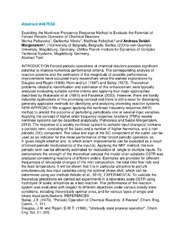Приказ основних података о документу
Exploiting the Nonlinear Frequency Response Method to Evaluate the Potential of Forced Periodic Operation of Reactors
| dc.creator | Petkovska, Menka | |
| dc.creator | Nikolić, Daliborka | |
| dc.creator | Felischak, Matthias | |
| dc.creator | Seidel-Morgenstern, Andreas | |
| dc.date.accessioned | 2021-03-10T12:57:17Z | |
| dc.date.available | 2021-03-10T12:57:17Z | |
| dc.date.issued | 2016 | |
| dc.identifier.isbn | 978-0-8169-1097-7 | |
| dc.identifier.uri | http://TechnoRep.tmf.bg.ac.rs/handle/123456789/3177 | |
| dc.description.abstract | Forced periodic operations of chemical reactors possess significant potential to improve numerous performance criteria. The corresponding analysis of reaction systems and the estimation of the magnitude of possible performance improvements have occupied many researchers since the earliest explorations by Douglas and Rippin (1966), Horn and Lin (1967) and Bailey (1973). Theoretical problems related to identification and estimation of the enhancement were typically analyzed evaluating suitable control criteria and applying four major approaches described by Watanabe et al. (1981) and Parulekar (2003). However, there are hardly industrial applications of this promising concept and there is still a need for developing generally applicable methods for identifying and analyzing promising reaction systems. NEW APPROACH We suggest applying the nonlinear frequency response (NFR) method to predict the outcome of perturbing periodically one or several input variables. Applying the concept of higher order frequency response functions (FRFs) weakly nonlinear systems can be described analytically (Petkovska and Seidel-Morgenstern, 2013). The response of a weakly nonlinear system to periodic input change(s) contains a periodic term, consisting of the basic and a number of higher harmonics, and a non-periodic (DC) component. The value and sign of the DC component of the outlet can be used as an indicator for the mean performance of the forced periodic operation, as it gives insight whether and to which extent improvements can be expected as a result of forced periodic modulation(s) of the input(s). Applying the NRF method, the non-periodic term can be efficiently estimated for modulation of single or multiple inputs. To demonstrate the strength of the theoretical concept the model of an adiabatic CSTR was analyzed considering reactions of different orders. Estimates are provided for different frequencies of sinusoidal changes of the inlet composition, the total inlet flow-rate and the feed temperature. It will be shown that it is in particular attractive to perturb simultaneously two input variables using the optimal phase shift, which can be determined using our method (Nikolic et al., 2015). EXPERIMENTAL To validate the theoretical predictions we carried out experiments in a laboratory scale CSTR using hydrolysis of acetic anhydride as a test reaction. The performance of the reaction system was evaluated with respect to different objectives under various steady state conditions, including theoretically optimal ones, and for various types of single and binary input perturbations. | en |
| dc.relation | info:eu-repo/grantAgreement/MESTD/Integrated and Interdisciplinary Research (IIR or III)/45001/RS// | |
| dc.relation | info:eu-repo/grantAgreement/MESTD/Basic Research (BR or ON)/172022/RS// | |
| dc.rights | openAccess | |
| dc.rights.uri | https://creativecommons.org/licenses/by/4.0/ | |
| dc.source | American Institute of Chemical Engineers Annual Meeting (AIChE Annual Meeting), San Francisco, USA | |
| dc.title | Exploiting the Nonlinear Frequency Response Method to Evaluate the Potential of Forced Periodic Operation of Reactors | en |
| dc.type | conferenceObject | |
| dc.rights.license | BY | |
| dc.identifier.fulltext | http://TechnoRep.tmf.bg.ac.rs/bitstream/id/1151/3174.pdf | |
| dc.identifier.rcub | https://hdl.handle.net/21.15107/rcub_technorep_3177 | |
| dc.type.version | publishedVersion |

